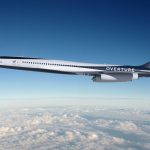The new Overture design is the culmination of 26 million core hours of simulated software designs, five wind tunnel tests, and the careful evaluation of 51 full design iterations.
With this updated configuration, Boom combines several engineering innovations in aerodynamics, noise reduction, and overall performance. Key features include a four-engine design, contoured fuselage and gull wings.
Overture will carry 65–80 passengers and run on 100% sustainable aviation fuel (SAF). It will fly Mach 1.7 over water with a range of 4,250 nautical miles. Its design elements are expertly engineered for peak supersonic performance, and it will go into production in 2024.
Here’s a deeper look at some of the key updates.
Overture Specifications
- Cruise speed: Mach 1.7 supersonic, Mach 0.94 subsonic
- Range: 4,250nm with full payload
- Passengers: 65–80
- Exterior Dimensions: Length – 201 feet, Wingspan – 106 feet, Height – 36 feet
- Wing: Gull with digital leading and trailing edge flap control
- Flight controls: 4x redundant digital fly-by-wire on 2 LRUs
- Powerplant: 4x medium-bypass 100% SAF-compatible turbofan
- Sustainability: Net zero carbon, flying on 100% SAF
- Airport Community noise: ICAO Chapter 14 / FAA Stage 5

Four-engine design
Driven by four powerful wing-mounted engines, Overture will cruise at Mach 1.7 over water and just under Mach 1 over land without afterburners.
The use of four engines keeps weight and temperature balanced and shrinks the size requirements of each engine, which allows the production of those engines to fall within the current supply chain and manufacturing capabilities.
Each engine is fed by a highly-efficient, streamline-traced, axi-symmetric inlet. These inlets provide exceptional pressure consistency that allows the engines to operate with subsonic airflow at supersonic speed. The inlet design is proven supersonic technology that affords easy maintenance with no new manufacturing pressures.
Engine placement was selected to conform to the strictest passenger safety requirements.

Quieter operation
Using four engines—as opposed to three—results in lower thrust requirements for each, which means reduced overall noise levels of the aircraft.
Overture will also employ the world’s first automated noise reduction system. With no afterburners and buzz-free engines, Overture’s takeoffs will blend in with existing long-haul fleets, resulting in a quieter experience for passengers and airport communities, meeting or exceeding ICAO (International Civil Aviation Organization) requirements for all subsonic aircraft operating over land and at or near airports.

Contoured fuselage
According to the principle of area-ruling, Overture’s fuselage has a larger diameter toward the front of the aircraft and a smaller diameter toward the rear. This design technique minimizes drag and maximizes fuel efficiency at supersonic speeds.
Gull wings and compound modified delta planform.
The proprietary gull wings allow air to flow smoothly over and around the aircraft. At the same time, the compound modified delta planform takes full advantage of natural fluid dynamics to enhance supersonic performance while sustaining conventional sub- and transonic efficiency.
The contoured wing profile reduces sonic shock strength and creates a swirling vortex along the entire wing surface, generating considerable lift and reducing engine stress.
In particular to Overture, this wing is a derivative of the traditional delta wing found on most supersonic aircraft. The delta planform is optimized for supersonic flight but does not operate optimally in lower-speed / subsonic conditions. The complex gull-wing design was selected to optimize cruise and low-speed conditions.
The benefit of this wing design and its ability to fly slower is higher overall safety. Taking off and landing at a relatively slower speed results in safer operations for customers.

Carbon composite construction
Overture will incorporate lighter, stronger, and more thermally stable carbon composite material into most of the build, representing another important first.
Decreasing weight makes the aircraft more fuel efficient, so this material choice will make Overture more sustainable. Carbon composites can also be manufactured more easily into the optimal shaping for area-ruling, contributing to the aircraft’s aerodynamic efficiency.
The carbon-fibre composites maintain strength at elevated temperatures better than aluminium. The composites expand and contract much less than metal under supersonic conditions, allowing Overture to fly at higher speeds more safely.

Net zero carbon
For Overture, circularity and fuel efficiency are critical pillars to drive sustainability at scale. To aid in the promise of achieving net zero carbon, Overture will be built to operate on 100% SAF. SAF is critical for the future of decarbonizing aviation.
Environmental performance is being considered in all aspects of Overture, from design and production to flight and end-of-life recycling. The engineering team prioritizes circularity by repurposing used tooling, recycling components on the shop floor, and leveraging additive manufacturing techniques that produce less waste and lighter, more fuel-efficient products.

A new era
Boom is on a mission to make the world more accessible by ushering in a new era of sustainable, supersonic commercial travel. The new supersonic era will allow us to reshape how and where we spend our time, offering travellers more moments to enjoy life where it matters most, with the people who matter most.
Boom seamlessly integrates today’s industry expectations and regulations while pushing the sector forward, from supply chain to production, safety requirements, passenger acceptance, and crew training.
Overture will be a highly profitable new addition to global commercial airline fleets, as it can fly twice as many of the well over 600 identified optimal routes in a day.
That means families can come together more often, entrepreneurs can explore more opportunities, businesses can connect more frequently, scientists and visionaries can exchange more ideas, first responders can arrive on-site faster — and everyone can benefit from a more connected world.
Edited by: Stephen Morton





















